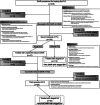Impact of unplanned second debridement, antibiotics and implant retention on long-term outcomes in knee exchange arthroplasty: Elevated risk of failure and reinfection
- PMID: 38694767
- PMCID: PMC11058667
- DOI: 10.1002/jeo2.12024
Impact of unplanned second debridement, antibiotics and implant retention on long-term outcomes in knee exchange arthroplasty: Elevated risk of failure and reinfection
Abstract
Purpose: This study investigates the outcomes of two-stage exchange arthroplasty (EA) for periprosthetic joint infection (PJI) following initial or unplanned repeat debridement antibiotics, and implant retention (DAIR).
Methods: We retrospectively reviewed cases of knee arthroplasty infection treated with two-stage EA after DAIR, spanning from January 1994 to December 2010. A total of 138 patients were included, comprising 112 with initial DAIR and 26 with an unplanned second DAIR. Data on demographics, comorbidities, infection characteristics and causative organisms were analyzed. The primary outcome was implant failure or reinfection, observed over a minimum follow-up of 10 years.
Results: The overall success rate for two-stage EA was 87% (119/138 patients). Factors identified for treatment failure included reinfection with the same pathogen for unplanned second DAIR (hazard ratio [HR] = 3.41; 95% confidence interval [CI] = 1.35-4.38; p = 0.004), higher reinfection rates in patients undergoing EA after an unplanned second DAIR, especially with a prior history of PJI within 2 years (HR = 4.23; 95% CI = 2.39-5.31; p = 0.002), pre-first DAIR C-reactive protein (CRP) levels over 100 mg/dL (HR = 2.52; 95% CI = 1.98-3.42; p = 0.003) and recurrence with the same pathogen (HR = 2.35; 95% CI = 1.32-4.24; p = 0.007). Additional factors such as male gender (HR = 3.92; 95% CI = 1.21-5.25; p = 0.007) and osteoporosis (T score < -2.5; HR = 3.27; 95% CI = 1.23-5.28; p = 0.005) were identified as risk factors for implant failure in all EA cases.
Conclusions: This study identifies key risk factors for worse knee EA outcomes following DAIR, including a pre-first DAIR CRP level over 100 mg/L, same pathogen recurrence, and PJI history within 2 years. It shows implant failure rates remain constant across EA cases, regardless of DAIR sequence, particularly with risk factors like male gender and severe osteoporosis (T score < -2.5). These results underscore the need for careful evaluation before an unplanned second DAIR, given its significant impact on EA success.
Level of evidence: Level III.
Keywords: debridement, antibiotics and implant retention (DAIR); implant failure; periprosthetic infection; reinfection; staged exchange arthroplasty.
© 2024 The Author(s). Journal of Experimental Orthopaedics published by John Wiley & Sons Ltd on behalf of European Society of Sports Traumatology, Knee Surgery and Arthroscopy.
Conflict of interest statement
The authors declare no conflict of interest.
Figures



Similar articles
-
Debridement, Antibiotics, and Implant Retention (DAIR) Plus Offers Similar Periprosthetic Joint Infection Treatment Success Rates to Two-Stage Revision in Oncologic Megaprosthesis.J Arthroplasty. 2024 Jul;39(7):1820-1827. doi: 10.1016/j.arth.2024.01.021. Epub 2024 Jan 14. J Arthroplasty. 2024. PMID: 38224789
-
Outcomes and risk factors for failure after débridement, antibiotics, and implant retention for elbow periprosthetic joint infection.J Shoulder Elbow Surg. 2023 Mar;32(3):475-479. doi: 10.1016/j.jse.2022.11.009. Epub 2022 Dec 21. J Shoulder Elbow Surg. 2023. PMID: 36565739
-
The Double DAIR: A 2-Stage Debridement with Prosthesis-Retention Protocol for Acute Periprosthetic Joint Infections.JBJS Essent Surg Tech. 2021 Feb 4;11(1):e19.00071-e19.00071. doi: 10.2106/JBJS.ST.19.00071. eCollection 2021 Jan-Mar. JBJS Essent Surg Tech. 2021. PMID: 34123550 Free PMC article.
-
Debridement, antibiotics, and implant retention after revision arthroplasty : antibiotic mismatch, timing, and repeated DAIR associated with poor outcome.Bone Joint J. 2022 Apr;104-B(4):464-471. doi: 10.1302/0301-620X.104B4.BJJ-2021-1264.R1. Bone Joint J. 2022. PMID: 35360944 Review.
-
Contemporary outcomes of debridement, antibiotics and implant retention in knee arthroplasty.Ann Jt. 2022 Jan 15;7:9. doi: 10.21037/aoj-20-76. eCollection 2022. Ann Jt. 2022. PMID: 38529130 Free PMC article. Review.
References
-
- Abdel Khalik, H. , Wood, T.J. , Tushinski, D.M. , Gazendam, A. , Petruccelli, D.T. & Bali, K. et al. (2023) Routine use of antibiotic‐laden bone cement in total knee arthroplasty is a cost‐effective practice in the single‐payer healthcare system. Knee Surgery, Sports Traumatology, Arthroscopy, 31(9), 3847–3853. Available from: 10.1007/s00167-023-07364-5 - DOI - PubMed
-
- Argenson, J.N. , Arndt, M. , Babis, G. , Battenberg, A. , Budhiparama, N. , Catani, F. et al. (2019) Hip and knee section, treatment, debridement and retention of implant: proceedings of international consensus on orthopedic infections. The Journal of Arthroplasty, 34, S399–S419. Available from: 10.1016/j.arth.2018.09.025 - DOI - PubMed
-
- Brimmo, O. , Ramanathan, D. , Schiltz, N.K. , Pillai, A.L.P.C. , Klika, A.K. & Barsoum, W.K. (2016) Irrigation and debridement before a 2‐stage revision total knee arthroplasty does not increase risk of failure. The Journal of Arthroplasty, 31, 461–464. Available from: 10.1016/j.arth.2015.08.044 - DOI - PMC - PubMed
LinkOut - more resources
Full Text Sources
Research Materials
Miscellaneous

